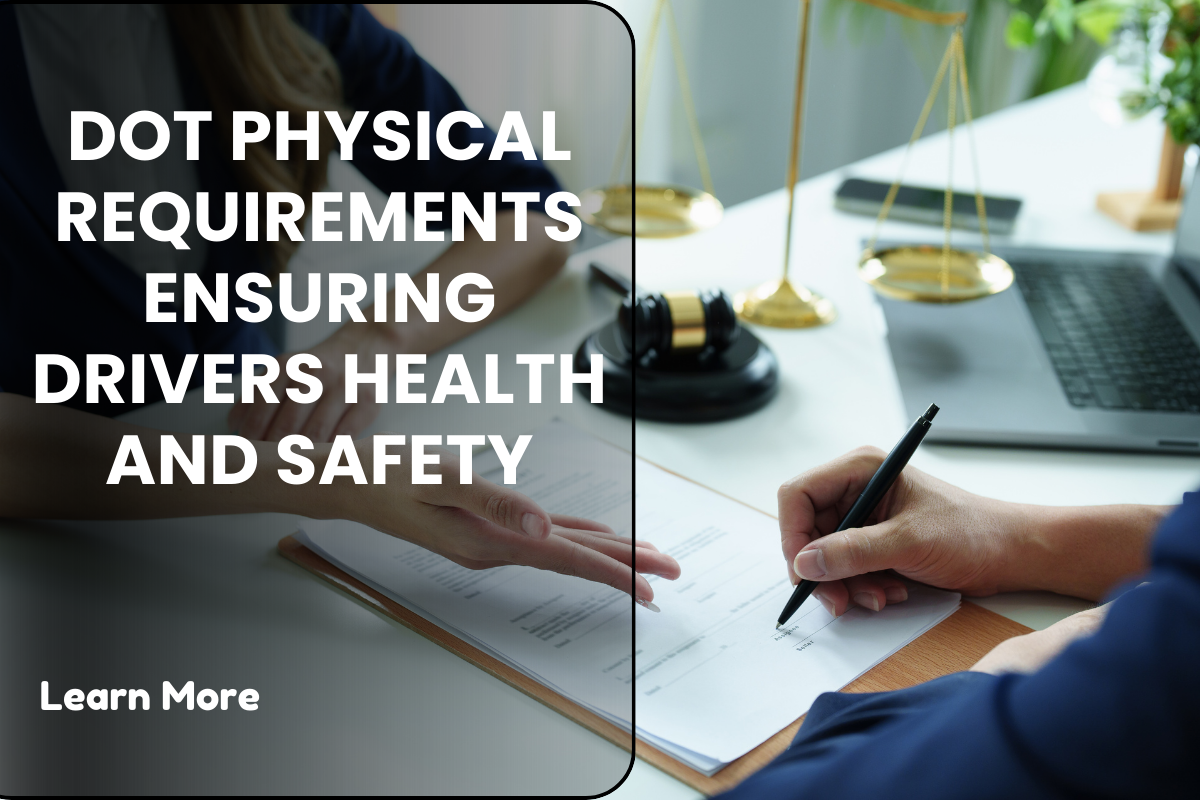
DOT Physical Requirements: Ensuring Fitness and Safety for Commercial Drivers
The Department of Transportation (DOT) physical examination is a mandatory health screening designed to ensure that commercial drivers meet the medical fitness standards necessary for operating heavy vehicles. These examinations play a pivotal role in maintaining road safety, preventing accidents caused by medical issues, and ensuring that drivers are physically capable of handling the demands of their profession. By identifying potential health risks, DOT physicals protect not only the drivers themselves but also other road users.
This article delves into the specifics of DOT physical requirements, explaining their purpose, the criteria drivers must meet, and the significance of maintaining health standards in the transportation industry.
Why Are DOT Physical Requirements Necessary?
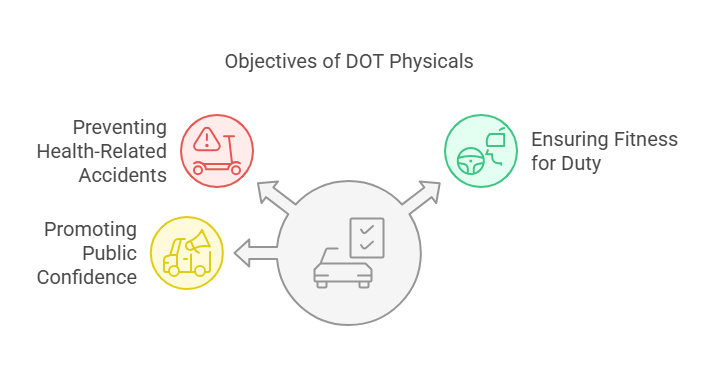
Operating a commercial vehicle is a demanding task that requires high levels of physical and mental acuity. Drivers often work long hours, face unpredictable conditions, and carry heavy responsibilities, such as transporting hazardous materials or operating passenger vehicles. These factors make health a critical component of a driver’s ability to perform their job safely.
DOT physicals, mandated by the Federal Motor Carrier Safety Administration (FMCSA), aim to reduce risks associated with medical impairments that could compromise road safety. The primary objectives of these exams include:
- Preventing Health-Related Accidents: Sudden medical emergencies, such as heart attacks, fainting, or vision impairment, can lead to catastrophic road incidents. Regular physicals help identify and address such risks.
- Ensuring Fitness for Duty: The physical and mental demands of commercial driving necessitate that drivers are in good health. DOT physicals assess whether drivers can safely handle these challenges.
- Promoting Public Confidence: The public relies on commercial drivers to transport goods and passengers safely. DOT physicals ensure that drivers meet stringent safety standards, fostering trust in the transportation system.
Key Criteria for Passing a DOT Physical Exam
To pass a DOT physical, drivers must meet specific health standards across several categories. These criteria are designed to assess their ability to operate commercial vehicles safely and effectively.
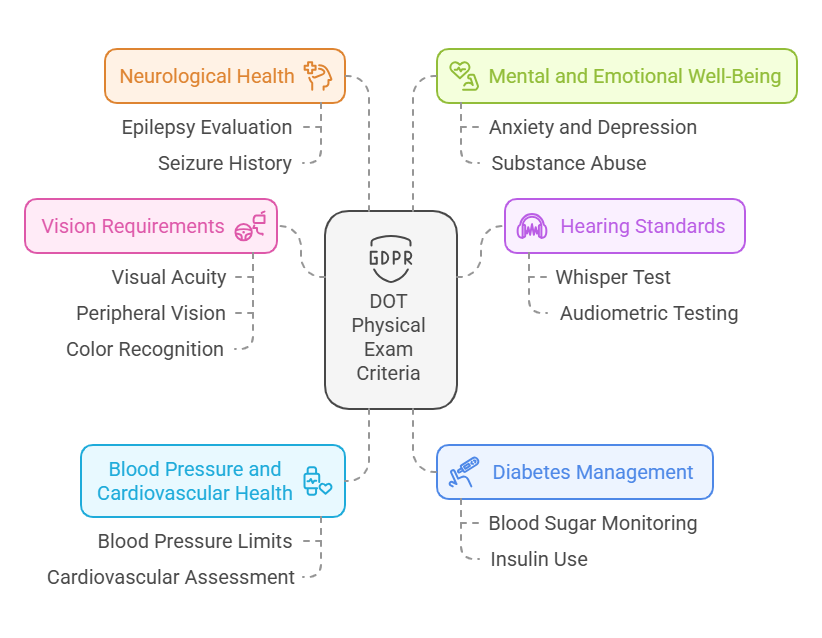
1. Vision Requirements
Good vision is essential for driving, as it allows drivers to respond to changing road conditions, recognize traffic signals, and avoid obstacles. The DOT sets strict vision standards, including:
- Visual Acuity: Drivers must have at least 20/40 vision in each eye, with or without corrective lenses.
- Peripheral Vision: A minimum field of 70 degrees in the horizontal meridian for each eye is required.
- Color Recognition: Drivers must distinguish between red, green, and amber, as these colors are crucial for interpreting traffic lights and road signs.
2. Hearing Standards
Hearing is another critical aspect of safe driving. It enables drivers to detect auditory warnings, such as sirens or honks, that may not be visible. The DOT hearing requirements include:
- Whisper Test: Drivers must hear a forced whisper at a distance of 5 feet, with or without a hearing aid.
- Audiometric Testing: Alternatively, drivers can pass by meeting specific thresholds during audiometric evaluations, ensuring their hearing is sufficient for safe driving.
3. Blood Pressure and Cardiovascular Health
Cardiovascular health is closely linked to a driver’s ability to handle the physical and emotional stresses of the job. High blood pressure or heart disease can lead to serious incidents, such as strokes or heart attacks, while driving. DOT standards include:
- Blood Pressure Limits: Readings must be below 140/90 mmHg to pass without restrictions. Drivers with controlled hypertension may still qualify for certification under certain conditions.
- Cardiovascular Assessment: A thorough review of any history of heart disease, arrhythmias, or other cardiovascular issues is conducted to ensure fitness for duty.
4. Diabetes Management
Uncontrolled diabetes can cause complications like fainting or loss of consciousness, posing significant risks while driving. DOT regulations require:
- Blood Sugar Monitoring: Drivers must demonstrate that their blood sugar levels are stable and within a safe range.
- Insulin Use: Recent FMCSA updates allow drivers using insulin to qualify for certification, provided they meet specific criteria and provide proper medical documentation.
5. Neurological Health
Neurological disorders, such as epilepsy or a history of seizures, are evaluated closely during the DOT physical. While certain conditions may disqualify drivers, others may be managed effectively with medical supervision, allowing for certification under specific guidelines.
6. Mental and Emotional Well-Being
Mental health plays a significant role in a driver’s ability to perform their job safely. The exam assesses drivers for conditions such as anxiety, depression, or substance abuse that could impair judgment or reaction times. Drivers are encouraged to seek treatment for mental health concerns, as controlled conditions do not necessarily disqualify them.
The DOT Physical Exam Process
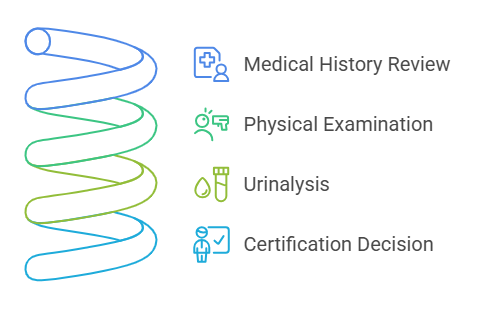
The DOT physical exam is typically conducted by a certified medical examiner listed on the FMCSA’s National Registry. The process includes the following steps:
- Medical History Review: Drivers provide information about their health history, including any chronic conditions, medications, or past surgeries.
- Physical Examination: The examiner evaluates the driver’s vision, hearing, blood pressure, and overall physical health.
- Urinalysis: A urine sample is tested for underlying medical conditions such as diabetes or kidney problems. Note that this is separate from drug and alcohol testing.
- Certification Decision: Based on the results, the examiner determines whether the driver is medically qualified to operate a commercial vehicle. Certifications are typically valid for up to two years, but drivers with certain conditions may receive shorter-term certifications.
Importance of Maintaining Health for CDL Holders
Commercial drivers face unique health challenges due to the nature of their work, including long hours, irregular schedules, and limited access to healthy food options. Maintaining good health is crucial for passing DOT physicals and ensuring a long, successful career in the industry.
Benefits of Good Health for Drivers
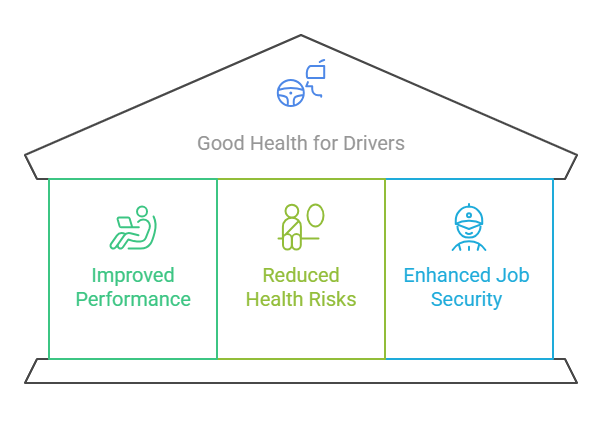
- Improved Performance: Healthy drivers experience better focus, quicker reaction times, and reduced fatigue.
- Reduced Health Risks: Regular check-ups and healthy habits help prevent chronic conditions that could disqualify drivers.
- Enhanced Job Security: Passing the DOT physical exam ensures continued eligibility for commercial driving roles.
Supporting Data and Statistics
According to FMCSA data, driver-related factors contribute to nearly 87% of large truck accidents, with health issues being a significant contributor. Common conditions such as sleep apnea, hypertension, and vision impairments are often linked to decreased alertness and slower reaction times, emphasizing the importance of DOT physical exams in identifying and addressing these risks.
A study conducted by the American Transportation Research Institute found that drivers with unmanaged health conditions are more likely to be involved in preventable accidents. This underscores the need for regular medical assessments to promote road safety.
The DOT Physical Exam Process, Requirements, and Compliance
The DOT physical exam is a vital component of the regulatory framework governing commercial drivers in the United States. Designed to ensure that drivers possess the physical and mental fitness needed to operate commercial vehicles safely, the exam follows a standardized process and enforces strict compliance requirements. This section explores the DOT physical exam process in detail, the specific health requirements for certification, common conditions that may impact eligibility, and how employers and drivers can navigate compliance challenges.
The Step-by-Step Process of Taking a DOT Physical Exam
The DOT physical exam process is methodical and designed to provide a comprehensive evaluation of a driver’s health. Conducted by certified medical examiners, the exam assesses a variety of physical, sensory, and mental health parameters. Below is a step-by-step breakdown:

Step 1: Completing Medical History Forms
Drivers are required to fill out a comprehensive medical history form detailing:
- Chronic health conditions (e.g., diabetes, hypertension).
- Past surgeries or hospitalizations.
- Prescription medications currently in use.
- Any history of substance abuse or mental health conditions.
Accuracy in completing this form is critical, as omissions or inaccuracies can lead to disqualification or delays in certification.
Step 2: Physical Health Examination
A certified medical examiner conducts a detailed physical assessment, focusing on key health indicators:
- Vision and Hearing: Ensures drivers meet minimum standards for visual acuity, peripheral vision, and hearing.
- Blood Pressure and Heart Health: Assesses cardiovascular health to rule out conditions that may impair safe driving.
- Musculoskeletal Fitness: Evaluates mobility and strength, particularly in areas critical for vehicle operation.
Step 3: Urinalysis
While separate from DOT drug and alcohol testing, a urinalysis is included in the physical exam to detect medical conditions such as:
- Diabetes (via elevated glucose levels).
- Kidney function issues.
Step 4: Certification Decision
Based on the findings, the examiner issues a medical certificate indicating the driver’s fitness for duty. Certificates are typically valid for up to two years, but drivers with certain medical conditions may receive a one-year or shorter certification period, requiring more frequent evaluations.
Specific Health Requirements for DOT Certification
To ensure compliance with the Department of Transportation’s regulations, drivers must meet several specific health requirements during their physical examination.
Vision Standards
- Minimum visual acuity of 20/40 in each eye, with or without corrective lenses.
- Peripheral vision of at least 70 degrees in the horizontal meridian of each eye.
- Ability to distinguish between traffic signal colors (red, green, amber).
Hearing Standards
- Ability to hear a forced whisper at a distance of five feet, with or without a hearing aid.
- Alternatively, audiometric testing may be used to determine compliance with DOT hearing standards.
Cardiovascular Health
- Blood pressure readings must be below 140/90 mmHg for unrestricted certification.
- Drivers with controlled hypertension or a history of cardiovascular conditions may require periodic medical monitoring or additional documentation.
Diabetes Management
- Drivers using insulin can qualify for certification if their condition is well-controlled and they provide medical documentation outlining their management plan.
- Hemoglobin A1C levels and blood sugar readings must remain within safe limits.
Neurological Conditions
Conditions such as epilepsy or a history of seizures are evaluated closely. While some drivers may qualify for exemptions, others may face disqualification if their condition poses a risk to road safety.
Mental Health
The exam also considers the driver’s mental and emotional well-being. Conditions such as anxiety, depression, or substance use disorders must be well-managed, and drivers may be required to provide documentation from a mental health professional.
Common Conditions That May Disqualify Drivers
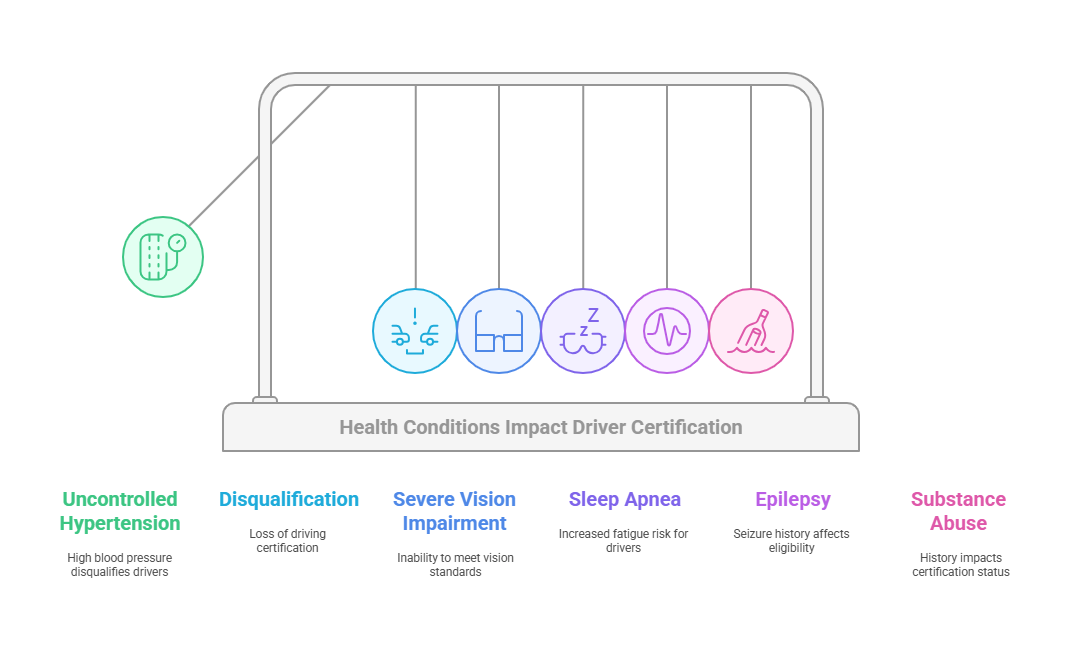
Several health conditions may prevent a driver from obtaining DOT certification, including:
- Uncontrolled Hypertension: Persistent high blood pressure can disqualify a driver, particularly if it exceeds 180/110 mmHg.
- Severe Vision Impairment: Drivers who cannot meet the minimum vision standards, even with corrective lenses, may be disqualified.
- Sleep Apnea: Untreated sleep apnea can result in excessive fatigue, increasing the risk of accidents. Drivers diagnosed with this condition must demonstrate adherence to treatment.
- Epilepsy or Seizure Disorders: Unless the driver has been seizure-free without medication for a specified period, they may be disqualified.
- Substance Abuse: A history of drug or alcohol dependency must be well-documented and in sustained remission to qualify for certification.
Compliance Requirements for Employers and Drivers
Ensuring compliance with DOT physical requirements is a shared responsibility between drivers and their employers. The Federal Motor Carrier Safety Administration (FMCSA) enforces strict regulations to maintain safety on the nation’s roadways.
Employer Responsibilities
- Record Keeping: Employers must retain medical certificates and ensure they are up-to-date.
- Periodic Reviews: Employers are responsible for verifying that drivers undergo regular physical exams in accordance with FMCSA guidelines.
- Monitoring Compliance: Employers must ensure that only certified drivers operate commercial vehicles.
Driver Responsibilities
- Honesty in Medical Reporting: Drivers must provide accurate information about their medical history.
- Timely Recertification: Drivers are responsible for scheduling and completing their physical exams before their certification expires.
- Adherence to Treatment Plans: Drivers with chronic conditions must comply with prescribed treatments to maintain certification.
RapidHireSolutions: Supporting Your DOT Physical Needs
Navigating the complexities of DOT physical requirements can be challenging, but RapidHireSolutions is here to help. We specialize in employment screening and DOT compliance services, offering streamlined solutions for both drivers and employers. Our services include:
- Scheduling DOT physical exams with certified medical examiners.
- Assistance with medical documentation and certification renewals.
- Comprehensive pre-employment and random drug testing services.
With RapidHireSolutions, you can ensure compliance with DOT regulations while simplifying the certification process.
Comparing DOT Physical Exams with Other Medical Evaluations
| Criteria | DOT Physical Exam | General Medical Check-Up | Specialized Occupational Exam |
|---|---|---|---|
| Purpose | Ensures fitness for commercial driving. | General health assessment. | Specific to unique job requirements. |
| Scope | Vision, hearing, cardiovascular, diabetes, and more. | Comprehensive but less focused on driving-specific factors. | Tailored to occupational hazards. |
| Frequency | Every 1–2 years. | Varies (annual recommended). | Varies based on job and industry. |
| Legal Requirement | Mandatory for CDL drivers. | Not legally required. | Required for certain occupations (e.g., hazardous materials). |
Preparing for a DOT Physical Exam
Proper preparation can significantly improve the likelihood of passing a DOT physical exam. Here are some tips:
- Review Medical History: Be ready to discuss any medical conditions, surgeries, or medications.
- Monitor Blood Pressure: Reduce salt intake, stay hydrated, and avoid caffeine before the exam.
- Ensure Vision and Hearing Compliance: Update corrective lenses or hearing aids if needed.
- Follow Treatment Plans: Adherence to prescribed treatments can prevent disqualification.
Legal Framework of DOT Physical Requirements
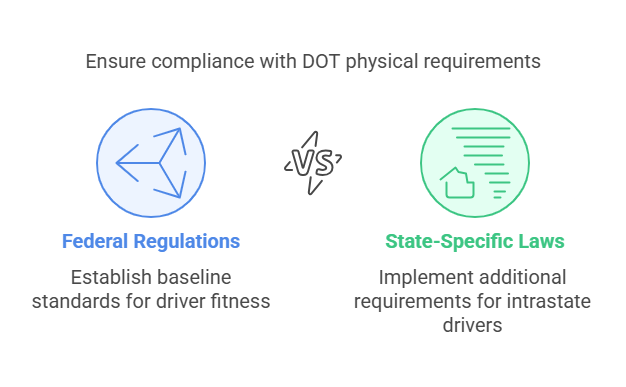
DOT physical requirements are established under the authority of the Federal Motor Carrier Safety Administration (FMCSA) to ensure that drivers are physically and mentally fit to operate commercial motor vehicles (CMVs). These regulations are intended to safeguard public safety by minimizing risks posed by health-related impairments in drivers.
Federal Regulations Governing DOT Physicals
The core legal framework is outlined in several key regulations:
- 49 CFR Part 391.41: This sets the minimum physical qualifications for drivers, covering aspects like vision, hearing, and cardiovascular health.
- 49 CFR Part 391.43: Specifies the medical examination procedures and the certification process for medical examiners.
- 49 CFR Part 40: Establishes rules for drug and alcohol testing, which are often conducted alongside DOT physical exams.
These federal regulations apply uniformly across the United States, ensuring that all interstate drivers meet the same high standards.
State-Specific Laws
While federal laws provide the baseline, states may impose additional requirements for intrastate drivers. Some states have specific laws regarding medical waivers, certification renewal periods, or additional tests for certain categories of drivers. Employers and drivers must familiarize themselves with both federal and state-specific regulations to ensure full compliance.
Key Compliance Requirements for Employers
Employers play a critical role in enforcing DOT physical requirements. Key responsibilities include:
- Maintaining Records: Employers must retain copies of drivers’ medical certificates for three years and ensure they are readily available for inspection.
- Monitoring Certification Validity: Employers must track expiration dates and ensure drivers renew their medical certificates on time.
- Enforcing Disqualification Rules: Drivers who fail to meet physical qualifications must be immediately disqualified from operating CMVs until they address the underlying issues.
Ethical and Privacy Considerations
The DOT physical exam process involves sensitive medical information, raising concerns about privacy and ethics. Several legal protections are in place to ensure that drivers’ rights are respected.
HIPAA Protections
The Health Insurance Portability and Accountability Act (HIPAA) safeguards the confidentiality of medical information obtained during the DOT physical exam. Key provisions include:
- Limited Disclosure: Only the results of the physical exam (i.e., whether the driver is certified or not) are shared with employers. Detailed medical history remains confidential.
- Secure Storage: Medical examiners and employers must store records securely to prevent unauthorized access.
- Informed Consent: Drivers must provide explicit consent before their medical information is shared.
Ethical Obligations of Medical Examiners
Certified medical examiners have an ethical duty to conduct DOT physicals objectively and without bias. They must adhere to FMCSA guidelines and avoid conflicts of interest, such as certifying unqualified drivers under pressure from employers.
Consequences of Non-Compliance
Failing to comply with DOT physical requirements can have serious repercussions for both drivers and employers.
For Drivers
- Disqualification: Drivers who fail to meet the physical qualifications are prohibited from operating CMVs.
- Limited Employment Opportunities: Drivers with unresolved medical issues may find it difficult to secure jobs in the transportation industry.
- Fines and Penalties: Drivers caught operating CMVs without valid medical certification may face fines or license suspension.
For Employers
- Legal and Financial Liabilities: Employers who allow non-compliant drivers to operate vehicles risk lawsuits, fines, and penalties.
- Loss of Operating Licenses: Repeated violations can result in the suspension or revocation of an employer’s operating authority.
- Reputation Damage: Non-compliance can harm a company’s reputation, making it less attractive to clients and potential employees.
Addressing Common Challenges in Meeting DOT Physical Requirements

Overcoming Health-Related Barriers
Certain medical conditions, such as diabetes, hypertension, and sleep apnea, can make it difficult for drivers to pass a DOT physical exam. However, these challenges are not insurmountable.
Managing Chronic Conditions
- Hypertension: Drivers with controlled blood pressure (below 140/90) can still qualify for a one- or two-year certification. Regular monitoring and medication adherence are essential.
- Diabetes: Drivers using insulin can apply for a Federal Diabetes Exemption Program, provided they demonstrate stable blood sugar levels and no history of complications.
- Sleep Apnea: Drivers with sleep apnea must demonstrate that the condition is being managed through Continuous Positive Airway Pressure (CPAP) therapy or other treatments.
Seeking Medical Waivers
The FMCSA offers waivers and exemptions for drivers with specific conditions, such as vision impairments or limb loss, if they can prove that their condition does not impair their ability to drive safely.
Preparing for the Exam
Proper preparation can improve the chances of passing the DOT physical exam.
- Know the Requirements: Familiarize yourself with the physical qualifications and address any known issues beforehand.
- Bring Necessary Documentation: Drivers with medical conditions should bring medical records, test results, and medication lists to the exam.
- Adopt Healthy Habits: Regular exercise, a balanced diet, and adequate sleep can improve overall health and exam outcomes.
FAQs About DOT Physical Requirements
How long is a DOT physical certification valid?
Most DOT physical certifications are valid for two years. However, drivers with certain medical conditions may receive a shorter certification period, such as three months or one year, depending on their health status.
Can I appeal if I fail a DOT physical?
Yes, you can seek a second opinion from another certified medical examiner. The results of the second exam will override the initial determination.
What should I bring to my DOT physical exam?
Bring a valid photo ID, your medical history, a list of current medications, and any documentation related to ongoing medical conditions (e.g., test results, treatment plans).
What happens if my medical certificate expires?
If your medical certificate expires, you are not legally permitted to operate a CMV until you renew it. Some states may downgrade your CDL to a regular driver’s license if you fail to provide a valid medical certificate within a certain timeframe.
Are there age restrictions for DOT physical certification?
No, there are no age restrictions as long as the driver meets all physical qualifications. Older drivers, however, may be subject to additional scrutiny during the exam due to age-related health concerns.
Conclusion
DOT physical requirements play a pivotal role in promoting road safety and ensuring that commercial drivers are fit for duty. These regulations, rooted in federal and state laws, create a standardized framework that balances public safety with the rights and privacy of individual drivers.
For drivers, staying informed about DOT physical requirements and prioritizing personal health can make the certification process more manageable. Employers, on the other hand, must uphold their responsibility to enforce compliance, maintain accurate records, and support their drivers in meeting these requirements.
At RapidHireSolutions, we simplify the DOT physical exam process, offering comprehensive services that cater to both drivers and employers. Whether you need assistance with scheduling exams, managing medical records, or navigating regulatory compliance, our team is here to help.
By fostering a culture of safety, health, and accountability, we can ensure that America’s roads remain secure for everyone. With the right knowledge and resources, drivers and employers alike can meet DOT physical requirements confidently, paving the way for a safer and more efficient transportation industry.
